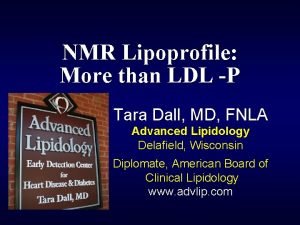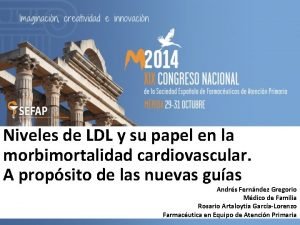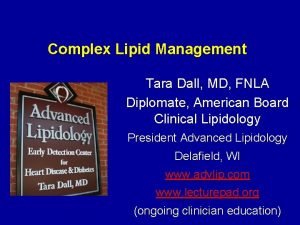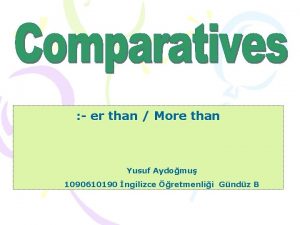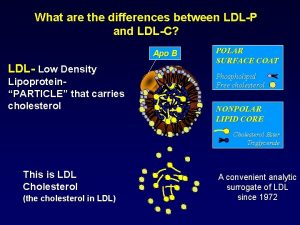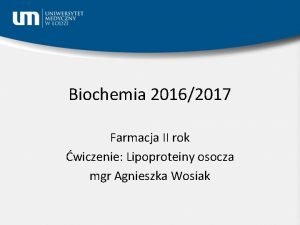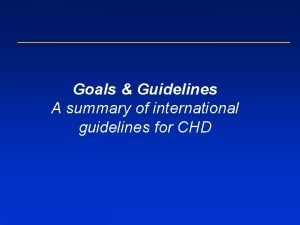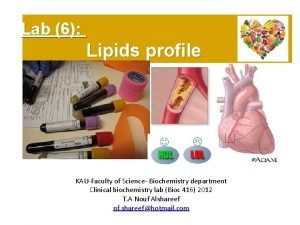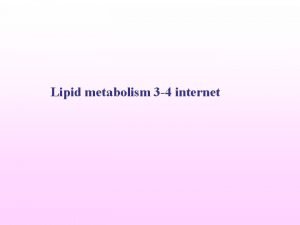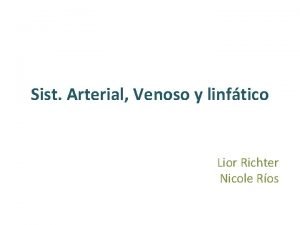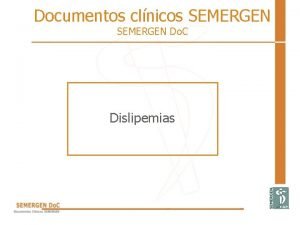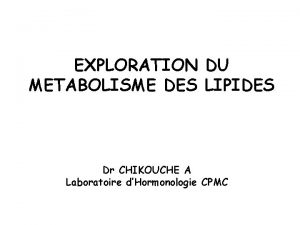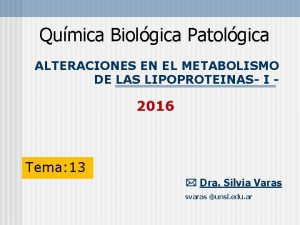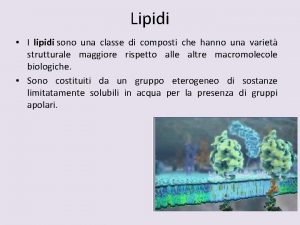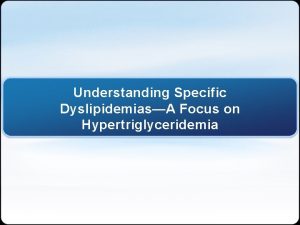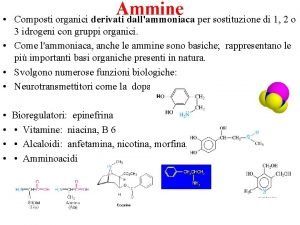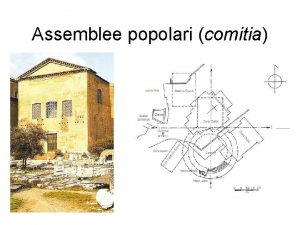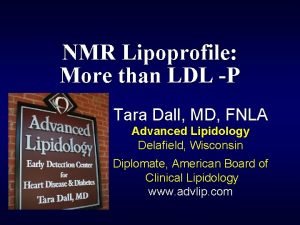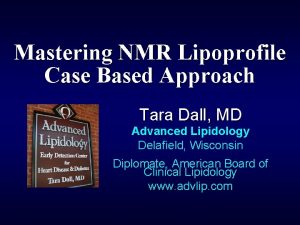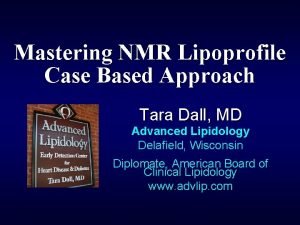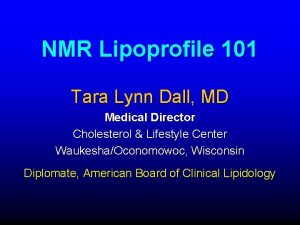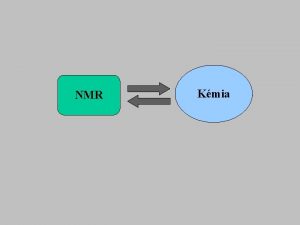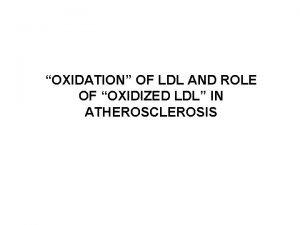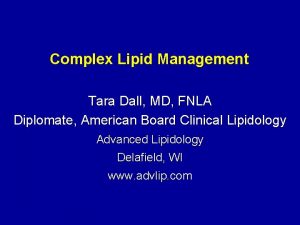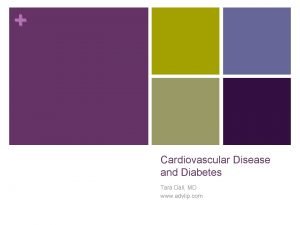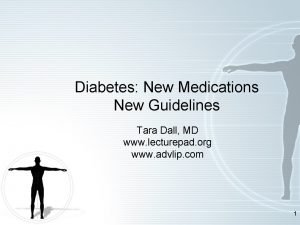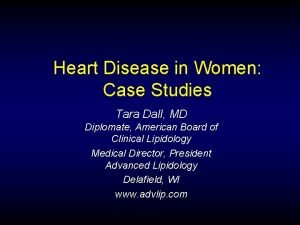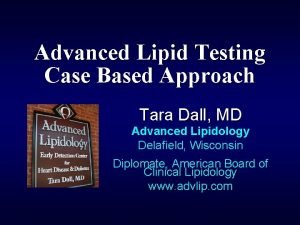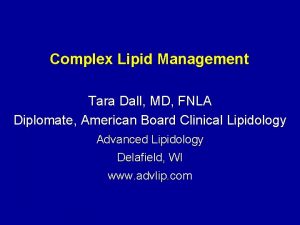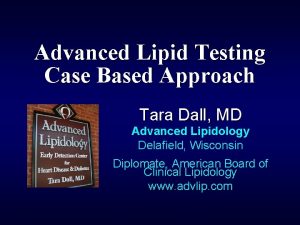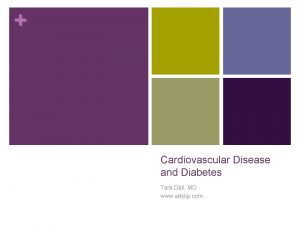NMR Lipoprofile More than LDL P Tara Dall



















































- Slides: 51

NMR Lipoprofile: More than LDL -P Tara Dall, MD, FNLA Advanced Lipidology Delafield, Wisconsin Diplomate, American Board of Clinical Lipidology www. advlip. com

LDL Particles Cause Atherosclerosis Low Density Lipoprotein particles (LDL) are the causal agents in atherosclerosis. 1 The more lipoprotein particles a person has, the higher the risk for plaque buildup that causes heart attacks, regardless of how much cholesterol those particles carry. 1 Fredrickson et al. NEJM 1967; 276: 148

LDL Cholesterol Is Not LDL!! Apo B This is an LDL particle (LDL-P) This is LDL Cholesterol (LDL-C) POLAR SURFACE COAT Phospholipid Free cholesterol NONPOLAR LIPID CORE Cholesterol Ester Triglyceride A convenient analytic surrogate of LDL since 1972

Lipoprotein Subclasses Density (g/ml) 0. 95 IDL 1. 006 1. 02 1. 06 1. 10 Chylomicrons VLDL Chylomicron Remnants LDL HDL 2 Lp(a) HDL 3 Apo B = non HDL-C 1. 20 5 10 20 40 60 Diameter (nm) 80 1000

Small LDL Particles Contain Less Cholesterol Than Large LDL Particles Up to 70% More Particles 100 mg/d. L Large LDL Small LDL Cholesterol Balance

Even LDL Particles of the Same Size can Differ in Cholesterol Content Up to 40% More Particles 100 mg/d. L Normal Cholesterol Per Particle Less Cholesterol Per Particle Cholesterol Balance

Weight of Evidence Over 180 NMR related papers published to Date

Disease States where LDL-Particle and LDL-Cholesterol are most likely to Differ and NMR testing should be considered F Known Coronary Heart Disease F Metabolic Syndrome F Diabetes F Family history premature heart disease F High Triglyceride and low HDL

Relations of LDL Particles and LDL Cholesterol to Levels of HDL Cholesterol and Triglycerides Otvos et al. , Amer J Cardiol 2002; 90: 22 i-29 i.

Weight of Evidence LDL-P more predictive than LDL-C 213 NMR related papers published to Date

Clinical Implications of Discordance Between Low-Density Lipoprotein Cholesterol and Particle Number James D. Otvos, Ph. D, Samia Mora, MD, MHS, Irina Shalaurova, MD, Philip Greenland, MD, Rachel H. Mackey, Ph. D, MPH, David C. Goff Jr. , MD, Ph. D Journal of Clinical Lipidology 2011; 5: 105 -113

LDL-P and LDL-C Discordance in MESA CVD Event Rates in Subgroups with Low LDL Residual Risk Otvos et al. J Clin Lipidol 2011; 5: 105 -13

LDL-P and LDL-C Discordance in MESA CVD Event Rates in Subgroups with Low LDL Residual Risk Discorcordant High LDL-P Concordant Discorcordant Low LDL-P Need Additional LDL-C Lowering? Otvos et al. J Clin Lipidol 2011; 5: 105 -13

Clinical Application

40 yr old female Primary prevention LDL –C 171 F Wt 147 lbs Ht 65. 6 BMI 24 F Waist 33 inches F BP 100/60 F PMH: hypothyroid stable nl TSH F FH: no premature CAD F SH: nonsmoker, healthy diet, exercises 150 min/week

Initial Presentation 40 yr old female Primary prevention LDL –C 171 LDL-P Sm LDL-P LDL-C HDL-C TG Total Chol 1267 (optimal <1300) <90 171 82 113 276 Disconnect high LDL-C but low LDL -P

Population Equivalent Cutpoints for Alternate LDL Measures (LDL-C, Measured Apo B and NMR LDL-P) Biomarker Population LDL-C (mg/d. L) Measured Apo B (mg/d. L) Percentile Equivalent Concentration < 5 th 20 th 50 th 80 th Framingham 1 < 70 100 LDL_C 130 160 Framingham 1 < 60 80 100 120 Framingham 1 < 850 LDL-P 1100 1400 1800 < 700 1000 1300 1600 NMR LDL-P (nmol/L) MESA 2 1 2 Contois, et al. Clinical Chemistry 2009; 55: 407 -419 Cromwell WC. Clinical Challenges in Lipid Disorders. Oxford: Clinical Publishing, 2008: 249 -259.

2 New Patient referrals Secondary Prevention 3/2011 F Both patients recent Myocardial Infarction referred for lipid treatment and work up genetic etiology F Both patients on Moderate dose stain at time NMR drawn

2 Men Secondary Prevention on Moderate Dose Statin post MI F 53 F yr Male BMI 29, 122/83 Total Chol 143 F LDL-C 57 F HDL-C 43 F TG 152 F Non HDL-C 100 F LDL particle # F • LDL-P 1835 F 58 F yr Male BMI 29, BP 122/78 Total chol 121 F LDL-C 60 F HDL c 45 F TG 81 F Non HDL-C 76 F LDL particle # F • LDL-P 1006

Treatments that Alter the Cholesterol Content of LDL Change LDL-C and LDL-P Differentially Cholesterol per particle decreases with: Cholesterol per particle increases with: • statins • niacin • statin + ezetimibe • fibrates • estrogen replacement therapy • pioglitazone • low fat, high carb diet • omega 3 FAs • exercise • low carb diet LDL-C More LDL-P More

Beyond LDL: Combination Therapy Statin 0 WOSCOPS 4 S vs CARE Statin/Niacin HPS FATS 10 YR HATS -10 -24 Percent -30 -40 -31 -25 -34 -50 -60 -70 -80 -95 -100 Reduction in CV Events Brown BG, et al. N Engl J Med. 2001; 345: 1583 -1592. -90

Same Day 2 Consults Completely different decision making based on NMR results

NMR lipoprofile Beyond LDL –P ….

Results From the Insulin Resistance Atherosclerosis Study Normal Glucose Tolerance (NGT) Impaired Glucose Tolerance (IGT) Diabetes (DM) P values 433. 1 550. 8 636. 3 0. 0001 21. 4 21. 2 20. 9 0. 0001 2. 6 3. 5 4. 7 0. 0001 48. 1 51. 3 55. 2 0. 0001 Large HDL-P (umol/L) 5. 1 4. 5 3. 9 0. 0001 HDL-P size (nm) 9. 0 8. 9 8. 8 0. 0001 Small LDL-P (nmol/L) LDL-P size (nm) Large VLDL-P (nmol/L) VLDL-P size (nm) NMR Lipoprotein Particle Concentrations In Normal Glucose Tolerance (NGT), Impaired Glucose Tolerance (IGT), Diabetes (DM) Subjects Goff, Metabolism 2005; 54: 264 -70

Women’s Health Study Adjusted hazard ratios for the association of lipoprotein measure with incident type 2 diabetes in quintiles 1 through 5 Small LDL-P (nmol/L) LDL-P size (nm) Large VLDL-P (nmol/L) VLDL-P size (nm) Large HDL-P (µmol/L) HDL-P (nm) Quintile 1 (<346) Quintile 2 (347 -553) Quintile 3 (554 -774) Quintile 4 (775 -1134) Quintile 5 (>1134) Ref. 1. 54 2. 09 2. 62 4. 04 Quintile 1 (<20. 5) Quintile 2 (20. 6 -21. 0) Quintile 3 (21. 1 -21. 5) Quintile 4 (21. 6 -21. 9) Quintile 5 (>21. 9) 4. 16 3. 04 2. 21 1. 63 Ref. Quintile 1 (<0. 1) Quintile 2 (0. 2 -0. 5) Quintile 3 (0. 6 -1. 8) Quintile 4 (1. 9 -3. 8) Quintile 5 (>3. 8) Ref. 1. 49 2. 54 2. 98 3. 11 Quintile 1 (<40. 6) Quintile 2 (40. 7 -43. 8) Quintile 3 (43. 9 -47. 3) Quintile 4 (47. 4 -52. 0) Quintile 5 (>52. 0) Ref. 1. 25 1. 67 2. 22 2. 80 Quintile 1 (<4. 0) Quintile 2 (4. 1 -5. 8) Quintile 3 (5. 9 -7. 7) Quintile 4 (7. 8 -10. 0) Quintile 5 (>10. 0) 4. 51 3. 19 2. 54 1. 72 Ref. Quintile 1 (<8. 5) Quintile 2 (8. 6 -8. 7) Quintile 3 (8. 8 -9. 0) Quintile 4 (9. 1 -9. 4) Quintile 5 (>9. 4) 4. 56 3. 97 3. 08 1. 72 Ref. Mora et al. 2010. Diabetes

Insulin Resistance Possibly years before Diabetes diagnosis Presents with abnormal Glucose IR SCORE >45 abnormal




Age-adjusted Percentage of U. S. Adults Who Were Obese or Who Had Diagnosed Diabetes Obesity (BMI ≥ 30 kg/m ) 2 1994 No Data Diabetes <14. 0% 14. 0 -17. 9% >26. 0% 1994 No Data 2008 2000 18. 0 -21. 9% 22. 0 -25. 9% 2008 2000 <4. 5% 4. 5 -5. 9% 6. 0 -7. 4% 7. 5 -8. 9% CDC’s Division of Diabetes Translation. National Diabetes Surveillance System available at http: //www. cdc. gov/diabetes/statistics >9. 0%

Diabetes: A global pandemic Low prevalence rate (<4%) Medium prevalence rate (4– 8%) High prevalence rate (≥ 8%) 438 m in 2030 (+54%) Europe North America 40 66 m 55 m +20% +43 53 m % 37 m +43% South and Central America Global Prevalence 52 m 27 m +93% Eastern Mediterranean and Middle East Africa 30 m 18 m +67% South-east Asia 101 m 59 m +71% 113 m 77 m +47% 285 m in 2010 Western Pacific 24 m 12 m +100% Source: IDF Diabetes Atlas 2010. www. diabetesatlas. org/map. Accessed 7 Sept 2010



Time Course of the Pathogenesis of Type 2 Diabetes diagnosis 46

Medications for Prediabetes F F No medications are U. S. FDA approved to prevent progression to diabetes Research has shown that metformin and acarbose seem promising at preventing progression from prediabetes to diabetes • Acarbose not in ADA guidelines – use should be case by case Consider using these in high risk patients (such as people with CV disease) Metformin has also been shown to reduce the incidence of diabetes in overweight and obese non-diabetic patients Diabetes Care. 1999; 22: 623– 634 Chaisson JL, et al. Lancet. 2002; 359: 2072– 2077 Andreadis EA, et al; Exp Clin Endocrinol Diabetes. 2008 Dec 3.

UKPDS 33 / 34: Effect of intensive glucose control on microvascular and macrovascular events Study Therapy Hb. A 1 c Results Microvascular Outcomes Macrovascular Outcomes UKPDS 33 Insulin or sulfonylurea vs. diet 7. 0% vs. 7. 9% (p<0. 0001) 25% risk reduction in microvascular events (p=0. 0099) 16% reduction in MI (NS) UKPDS 34 Metformin vs. diet 7. 4% vs. 8. 0% (p not stated) 32% risk reduction in any diabetes-related endpoint* (p=0. 002) 39% reduction in MI (p=0. 011) 30% reduction in macro-vascular endpoints (p=0. 02) 10–year follow-up studies of UKPDS 33 and 34 found that the difference in Hb. A 1 c levels was lost after 1 year, but that the reduction in any diabetes-related endpoint* was maintained (HR=0. 91, 95% CI 0. 83 – 0. 99 and 0. 79, 95% CI 0. 66 – 0. 99 respectively). Reduction in MI rates were also maintained at 15% (p=0. 01) and 33% (p= 0. 005) respectively *Any diabetes-related endpoint: sudden death, death from hyperglycemia or hypoglycemia, fata l or non-fatal MI, angina, heart failure, stroke, renal failure, amputation, vitreous hemorrhage, retinopathy, blindness, cataract Brown et al, Nat Rev Cardiol 2010; 7: 369 -375

UKPDS : Ten-year follow-up of intensive glucose control in type 2 diabetes Holman RR, Paul SJ, Bethel MA, et al. N Engl J Med 2008

Meta-analysis 40 Randomized Controlled Trials F Patients with type 2 diabetes may have a lower risk of cardiovascular death when treated with metformin F 26% Relative risk reduction in cardiovascular mortality with Metformin compared with other drugs or placebo AND IT IS VERY INEXPENSIVE THERAPY Selvin E, et al " Arch Intern Med 2008; 168: 2070 -2080.

Case Study Application NMR defined Insulin resistance

45 yr Female Dyslipidemia F Excellent diet (low glycemic) and exercises daily F FH: no premature CAD, Diabetes mother and mgma F Maximized TLC and dyslipidemia persists

45 yr Female Dyslipidemia max TLC F F F Lipids • Total Cholesterol • LDL-C • HDL-C • Triglycerides • Non HDL C Fasting Glucose Hg. AIC hs. CRP BP BMI 250 150 56 220 194 100 5. 6 3 120/82 25

AHA CVD Prevention Guidelines for Women 2011 Criteria Risk Status At risk (≥ 1 major risk factor[s] Cigarette smoking SBP ≥ 120 mm Hg, DBP ≥ 80 mm Hg or treated HTN TC ≥ 200 mg/d. L, HDL-C < 50 mg/d. L or treated dyslipidemia Obesity, particularly central adiposity Poor diet Physical inactivity Family history of premature CVD occurring in first degree relatives In men < 55 y of age or in women < 65 y of age Metabolic syndrome Poor exercise capacity on treatment on treadmill test and/or abnormal heart rate recovery after stopping exercise Systemic autoimmune collagen vascular disease (eg, lupus, rheumatoid arthritis) History of preeclampsia, gestational diabetes or pregnancy-induced hypertension Mosca, L. et al. Circulation 2011; 123:

AHA CVD Prevention Guidelines for Women Clinical Recommendations Major Risk Factor Interventions ► Lipids; Pharmacotherapy for LDL-C lowering: other at- risk women ►LDL-C lowering therapy with lifestyle therapy is useful if LDL-C is ≥ 130 mg/d. L, there are multiple risk factors, and the 10 -y absolute risk is 10 -20% (Class I; Level of Evidence B) ►LDL-C lowering therapy with lifestyle therapy is useful if LDL-C is ≥ 160 mg/d. L, there are multiple risk factors, even if the 10 -y absolute risk is <10% (Class I; Level of Evidence B) ►LDL-C lowering therapy with lifestyle therapy is useful if LDL-C is 190 mg/d. L, regardless of the presence or absence of other risk factors (Class I; Level of Evidence B) Mosca, L. et al. Circulation 2011; 123:

45 yr Female Dyslipidemia max TLC LDL-P Sm LDL-P LDL-C HDL-C TG Total Chol Non HDL-C IR SCORE Hg. AIC 5. 6, Glucose normal 2552 (very high) 1732 (very high ) 150 56 220 250 194 65 (abnormal >45)

Treatment options ? LDL-P 2552, LDL-C 150, TG 220 FStatin FNiaspan FFibrate FCombination FMetformin FPioglitazone FOthers

2 month follow up F LDL-P 1440 (1068 pt drop) F Small LDL-P 592 (1140 pt drop) F What intervention caused this drop? F Metformin ER 1500 mg/day F 5 pound weight loss

Other lab changes F LDL-C F TG F HDL F hs. CRP F IR Score 147 99 62 1 42 (150) (220) (56) (3) (65)

Metformin an easy sell… F You lose weight F LDL P decreases F Triglycerides decrease F HDL may increase F Shown to prevent progression to diabetes F Cardiovascular mortality benefit F Pregnancy Category B F And it’s a very inexpensive generic drug

Conclusions: LDL-P (via NMR) for Risk Assessment Primary Prevention: risk stratify more accurately, target therapy appropriately Avoid overtreatment of high LDL –C when LDL-P optimal Pediatric patients : better assess who should be treated more aggressively with statins

Risk Management Identify Metabolic syndrome/Insulin resistance before traditional tests become abnormal Its our “window into Diabetes” Treating this common secondary cause may prevent need for lifelong lipid lowering therapy NMR clinical benefits beyond LDL–P

Questions? taradall@advlip. com www. advlip. com
 More more more i want more more more more we praise you
More more more i want more more more more we praise you More more more i want more more more more we praise you
More more more i want more more more more we praise you Nmr lipoprofile
Nmr lipoprofile Nmr lipoprofile
Nmr lipoprofile Nmr lipoprofile
Nmr lipoprofile Tara dall
Tara dall Er than more than
Er than more than 5730x5
5730x5 Better than god
Better than god Ldl vs ldlc
Ldl vs ldlc Lpl biochemia
Lpl biochemia Ldl
Ldl Ldl goals guidelines
Ldl goals guidelines Hdl ldl
Hdl ldl Hdl ldl
Hdl ldl Ldl
Ldl Equivalencias estatinas
Equivalencias estatinas Taux normal cholesterol ldl femme
Taux normal cholesterol ldl femme O que é ldl
O que é ldl Circolazione enteroepatica
Circolazione enteroepatica Cholesterol total
Cholesterol total Quale continente è tagliato a metà dall'equatore
Quale continente è tagliato a metà dall'equatore Dall'aurora al tramonto canto ingresso
Dall'aurora al tramonto canto ingresso La cmr si applica ai traslochi
La cmr si applica ai traslochi Dal bello al vero
Dal bello al vero Impianto autodiegetico
Impianto autodiegetico Riciclo della carta
Riciclo della carta Dall'infinitamente piccolo all'infinitamente grande
Dall'infinitamente piccolo all'infinitamente grande La vita che avrai non sarà mai distante dall'amore che dai
La vita che avrai non sarà mai distante dall'amore che dai Cinzia parolini
Cinzia parolini La forza centrifuga si modifica variando la velocità
La forza centrifuga si modifica variando la velocità Esagono parallelo al pv
Esagono parallelo al pv Hhnh
Hhnh Conversione dall'erudizione al bello
Conversione dall'erudizione al bello Caroline dall
Caroline dall Pro vento energia
Pro vento energia Impianto frenante oleopneumatico
Impianto frenante oleopneumatico Letto visto dall'alto disegno
Letto visto dall'alto disegno Pareggiate dall imbianchino
Pareggiate dall imbianchino Lunetta aldobrandini
Lunetta aldobrandini La parola bullismo deriva dall'inglese
La parola bullismo deriva dall'inglese Dall'icidh all'icf
Dall'icidh all'icf Capability approach tfa
Capability approach tfa Domenico dall'olio
Domenico dall'olio Greater than less than fractions
Greater than less than fractions Alphablocks
Alphablocks Key words for inequalities
Key words for inequalities Compound inequality examples
Compound inequality examples Percents less than 1
Percents less than 1 Which fraction is the odd one out
Which fraction is the odd one out Jesus lord of heaven
Jesus lord of heaven Why is mass more useful than weight for measuring matter
Why is mass more useful than weight for measuring matter


